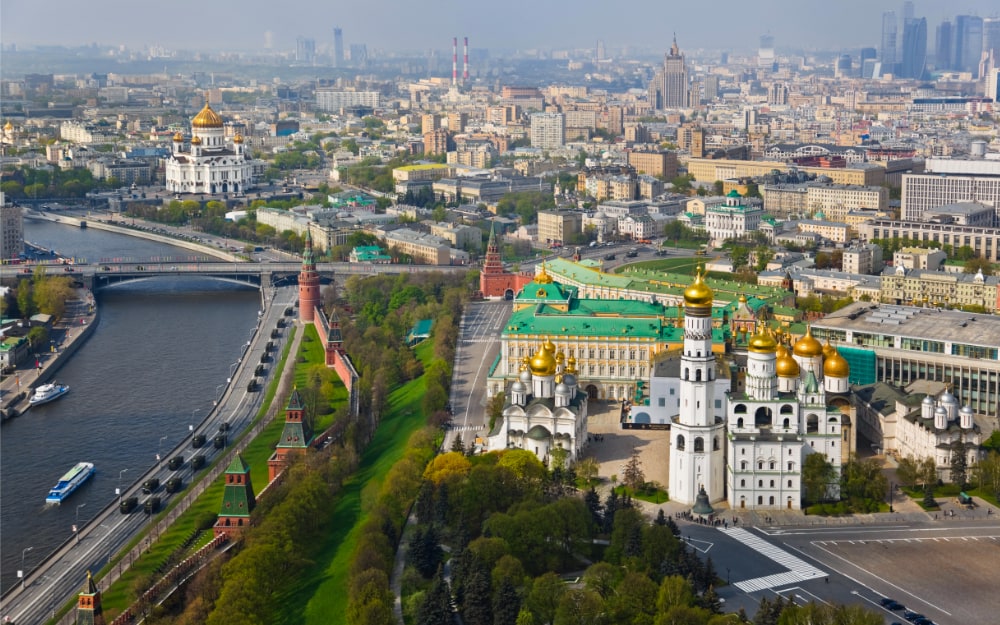Population in Urban Area, now
- World: 26th
- Europe: 1st
- Russia: 1st
Population in City Area, 2022-10-12
- World: 13th
- Europe: 1st
- Russia: 1st
Moscow Urban Area Population Graph
Moscow Population Review
Moscow is the capital of Russia and the northernmost major city in the world. With 12.5 million people in the urban area, it is also the second most populated city in all of Europe, topped only by Istanbul in Turkey. Beginning in the fourteenth century, the city of Moscow grew around the Moscow Kremlin—the fortified complex in the city center. The city straddles both sides of the Moskva River and has a rich and storied history.
The true population of Moscow is a hotly debated topic; with experts claiming the true number of people living in the city could be as high at 17 million. This is due to the city’s high rates of illegal immigration and the veracity of Russia’s official figures leaving something to be desired.
Death rate outstripping birth rate
While Moscow continues to grow at impressive (though contended) rates, the city’s death rate has actually been higher than birth rate for years now. Without legal and illegal migration into the city, Moscow’s population would have been decreasing for years. Instead, it grew 10.9% from 2002 to 2010, and experts predict it will reach almost 13 million by 2035.
Third busiest metro in the world
Moscow has always been a large city, but in 2012 it doubled in size. The city’s territorial expansion southwest into Moscow Oblast took the Russian capital from 1,000-square kilometers, to 2,511-square kilometers (and also added another 233,000 people to its population). All this room to travel means Muscovite’s need a reliable way to get around. The Moscow metro system is the third busiest in the world and serves more passengers on a daily basis than any other metro system on Earth. In fact, on weekdays the Moscow metro system shuttles up to 6-million people around the city. At peak times, the wait between trains is only 1.5 minutes before another flood of people are embarking and disembarking.
A homogenous population
Out of Moscow’s 12.5 million confirmed residents, only about 10 million have listed ethnicity. But even with those spotty numbers, Moscow is a mostly homogenous city with 91% (or about 9.9 million) of the population identifying as Russian. The second largest demographic is Ukrainian, but that is only a paltry 1.4% of the population. This is the section of the population that holds permanent residency and does not take into account the 1.8 million official “guests” that have visas, or the number of illegal immigrants, the majority of which are from Central Asia.
A record-setting city for tourism
Every year, Moscow breaks its old tourism records. The capital city’s rich history, culture and hospitality continue to draw huge crowds from other cities and countries. In 2015, the city saw 17.2 million tourists visit, and the next year saw 17.5 million. In 2017, there were 21.6 million tourists, which included five million foreigners. In 2018, the city hosted the 2018 FIFA World Cup and this boosted the tourism industry far beyond anything the city had ever seen. Tourism increased by 10% that year, going up to 22.9 million visitors and during the World Cup alone, there were 2.3 million foreigners visiting the city.
The heart of Eastern Orthodox Christianity
While Russia a multi-faith nation, the vast majority of the population practice Orthodox Christianity (75%). Moscow is the capital of Eastern Orthodox Christianity, which has long been a part of the country’s history and is considered the country’s traditional religion. So much so that it was deemed a part of Russian’s historical heritage in 1997. Islam is another religion that many Muscovites follow. Muslims constitute around 1.5 million people in Moscow, about 14% of the population, and there are four mosques in the city.
